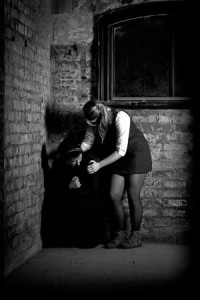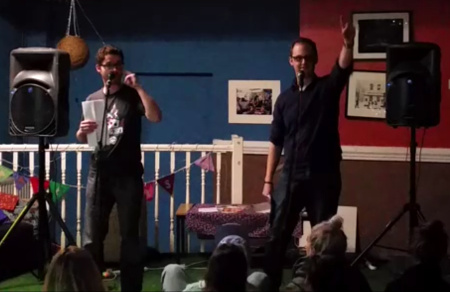Review: The Greatest Sin of All
Article published: Monday, April 11th 2011
Set against the backdrop of Manchester’s imposing Victoria Baths, The Greatest Sin of All is a moving representation of Nazi atrocities during the Second World War. Robin Macdonald reviews Schmucks Theatre Company’s latest production.
 For nearly sixty years Holocaust survivors, such as the writer Elie Wiesel, have grappled with the impossibility of representing the Holocaust. The horrors of Nazi atrocities, most agree, cannot be comprehended by those who did not experience them. With this in mind, Jo Gewirtz, Kitty Critchley and Nathan Shreeve, the play’s directors, do not seek to make sense of the Holocaust. Instead, The Greatest Sin of All evokes the strength, suffering, and resilience, of people subjected to unimaginable cruelties.
For nearly sixty years Holocaust survivors, such as the writer Elie Wiesel, have grappled with the impossibility of representing the Holocaust. The horrors of Nazi atrocities, most agree, cannot be comprehended by those who did not experience them. With this in mind, Jo Gewirtz, Kitty Critchley and Nathan Shreeve, the play’s directors, do not seek to make sense of the Holocaust. Instead, The Greatest Sin of All evokes the strength, suffering, and resilience, of people subjected to unimaginable cruelties.
The site-specific promenade piece takes the audience on a journey from the ghettos of Krakow through the homes of political dissenters, the horrors of the Nazi death marches, and, finally, to the infamous Nazi gas chambers. Yet the play is not simply a sequence of unrelated episodes. Several characters reappear in later scenes, giving it a sense of narrative continuity. Rather than simply attempting to portray the physical horror of Nazi persecution, the highly versatile cast combine physical theatre, singing, and even music to represent the emotional turmoil of those persecuted by the Nazis.
The baths themselves provide a suitably grim setting for the performance. As the audience descend into the basement at the beginning of the performance, the sudden cold air evokes a sharp sense of foreboding. Once downstairs, the spectators crowd into a small grubby room to hear the story of Joseph and Sara, two characters who attempt to maintain some semblance of normality despite their persecution. Scenes such as these provide a stark contrast to the horrific brutality of later episodes, in which prisoners are brutally murdered by their guards.
 Upstairs, the baths’ white, tiled walls provide an evocative and troubling backdrop to scenes about genetic experimentation on concentration camp detainees and the ‘shower blocks’ or gas chambers in which many met their deaths.
Upstairs, the baths’ white, tiled walls provide an evocative and troubling backdrop to scenes about genetic experimentation on concentration camp detainees and the ‘shower blocks’ or gas chambers in which many met their deaths.
Despite the undoubted discomfort caused by long periods spent in the unheated baths, the actors give impressive performances. At times, the audience feels as though they are looking in on the intimate lives of characters, who are unaware they are being watched. At others, the performers address the spectators directly, prompting them to confront the reality of the victims’ suffering. Samantha Vaughan’s portrayal of Agathe, a woman who has survived humiliation, torture, and rape in a Nazi death camp, is unfalteringly intense. ‘We didn’t cry out’, she tells the audience, ‘because we knew no one would help us’. The message is clear: humanity must never allow such atrocities to re-occur.
Leaving the baths, I felt emotionally drained. Whilst acknowledging the impossibility of representing the Holocaust, Schmucks have created an evocative piece which nonetheless provokes shock, anger, and horror. This is certainly not a performance I’ll forget in a hurry.
Comments
No comments found
The comments are closed.



